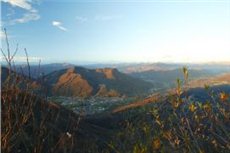Dry meadows
This natural habitat, which is becoming increasingly rare, is characteristic for its unusual type of vegetation, with many orchids and vast areas of grassland.
Dry meadows are semi-natural habitats with a high environmental value. They feature plant and animal species that are disappearing from these areas, and more specifically a number of orchid and butterfly species which find an ideal habitat in this ecosystem.
Dry meadows are areas that developed in locations in which man, centuries ago, cut forests and shrubland in order to grow crops and graze cattle.
As agriculture is disappearing in these areas, many species of environmental importance, whose survival is linked to the regular cropping of grass, risk disappearing.
The Campo dei Fiori Park Authority receives community finance, and so in recent years it has been able to reclaim this type of meadowland. Some such areas can be seen at the locations named Pregambaritt and Valicc, above Brinzio; near Santa Maria del Monte; in the vicinity of Bregazzana; in Cabiaglio, Bedero and Rancio, on the Martica and the Chiusarella, where livestock, above all, goats, is still farmed.
Dry meadows are semi-natural habitats with a high environmental value. They feature plant and animal species that are disappearing from these areas, and more specifically a number of orchid and butterfly species which find an ideal habitat in this ecosystem.
Dry meadows are areas that developed in locations in which man, centuries ago, cut forests and shrubland in order to grow crops and graze cattle.
As agriculture is disappearing in these areas, many species of environmental importance, whose survival is linked to the regular cropping of grass, risk disappearing.
The Campo dei Fiori Park Authority receives community finance, and so in recent years it has been able to reclaim this type of meadowland. Some such areas can be seen at the locations named Pregambaritt and Valicc, above Brinzio; near Santa Maria del Monte; in the vicinity of Bregazzana; in Cabiaglio, Bedero and Rancio, on the Martica and the Chiusarella, where livestock, above all, goats, is still farmed.





